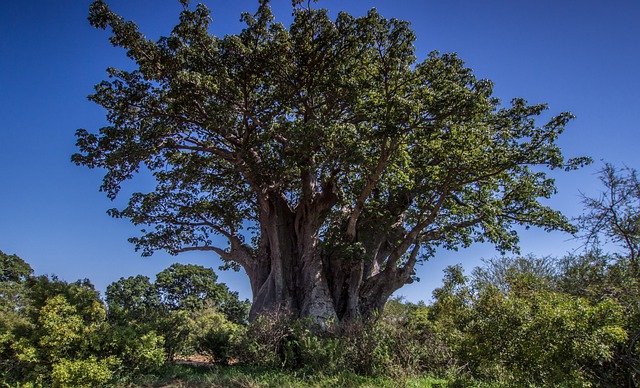The African Baobab Tree (Adansonia digitata) is known as a true tree of life.
The Baobab is one of the oldest among the trees and it looks not only very impressive with its height of 15 to 20 meters but can live for several thousand years too.
Also, its canopy with a diameter of 20 meters is difficult to find.
The Baobab tree is used against many diseases.
It can strengthen the immune system and provide relief for a wide variety of diseases of the gastrointestinal tract.
Above all, all parts of the tree are edible and can be prepared differently.
Origin and Nature of the Baobab
The Baobab is based in the African savanna and impresses with its amazing size.
Its name is derived from the Arabic term “bu hibab” and means “Fruit with many seeds”.
The root of the Baobab, with a diameter of about 10 meters, consists of spongy fiber that can save much water.
So the tree can endure longer drying times. There is also the very thick bark, with about 10cm, protection against smaller Bush fires to make the Baobab Tree survive very well.
The root is relatively short compared to the Crown.
The tree has no leaves, the Crown looks like a root system.
Mysteries about its Origin
There are mysteries about its origin and it’s funny to share these stories with you.
“Some thought that the devil has pulled the tree out of the ground and first
put it into the ground with the branches.
According to another legend, he saw a Hyena in the water to see how ugly it
was and tore the Baobab out of the ground before loud rage and threw them into the sky to their creator.
Because he missed his target with the tree, it fell back on the Earth and vice versa got stuck in the ground.
In addition, it also means that the Baobab was going to be the most beautiful tree and after this didn’t work, he put its head into the ground and the root system extends upwards.”
Baobab Cultivation
The root system of young Baobab trees leads vertically into the ground.
First, if the Baobab tree grows older, it can develop a lateral root system that can range up to a depth of 1.80 meters into the Earth.
Elephants, for example, use the Baobab as a natural water source, by breaking up the bark with their tusks.
With the trunk, they then bring out the fibers soaked with water to absorb the moisture.
You can get Baobab In many nurseries and garden stores and start growing it in your garden; it thrives almost anywhere but not so much in Africa.
However, it can get quite a height of several meters if the ground is nutritious.
When the Baobab tree is planted in a pot, it should be repotted every two years.
In the garden, however, it can grow and thrive and requires no water in the winter.
However, it must be protected from Frost.
The site is particularly important because the Baobab Tree prefers a bright and sunny place.
It’s entirely possible to put it directly on the window, or in the garden in the direct sun.
Caution is advised in irrigation because one of the requirements of the Baobab tree is that, it requires not much water.
In fact, if it’s in the garden and it’s raining much, the pot should be provided with sufficient holes so that the water can flow out easily.
Usually, the Baobab Tree is watered but only in the summer, when it is completely dried out.
In winter, only enough nutrients in the soil must be present so casting can be avoided.
Baobab should be fertilized in the summer about 1 to 2 times per month.
This should be used as a special fertilizer for Baobab trees. If you pay attention to these things, you can then hold Baobab in the garden or in the winter garden easily.
It’s an undemanding tree which is very easy to clean and also a beautiful ornamental plant.
Properties of the Baobab Tree and Fruit
It’s one of the most popular tree species and is useful for humans and animals.
It can take several years before flowering but it blooms about six months later, it develops the first fruits.
Sometimes, it looks as if the egg-shaped fruits were extra hung in the Baobab, they grow on drooping stems.
The fruits of the tree, which can reach a size of up to 40 centimeters, ripen in about 8 months, and depending on the region, they are ovoid, oblong, or globose.
During this maturation period, they change color from greenish to yellow or brown tint.
It tastes sour pulp due to the very high vitamin C content, and has a solid to brittle consistency, and has edible seeds inside, which contain much fat and are kidney-shaped.
To make the valuable Baobab powder from the fruits, they hang very long on the tree.
Harvesting Baobab
When dried enough, the ripe fruit is harvested and fibers and pulp are separated from each other.
Then, the pulp is processed to the excellent Baobab powder.








